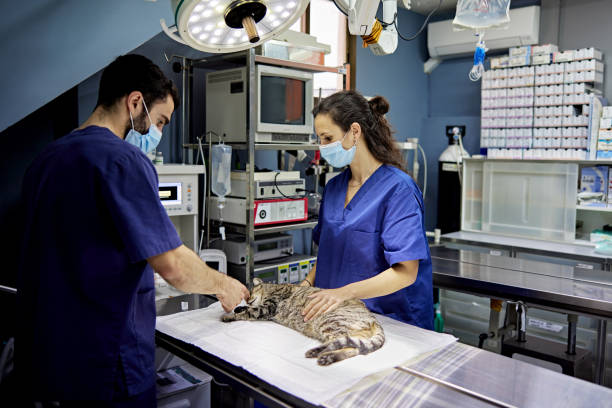
Cat Declaw Procedure
Nobody really likes the idea of declawing a cat… especially the cat! Most veterinarians will ask the owner about the reasons for requesting to have a cat declawed. Often the response is “Well, it’s going to be an indoor cat, so don’t all indoor cats have to be declawed?”
he answer, of course, is “No”. Many indoor cats live a long and happy life with their claws intact, and their owners have no reason to consider having them removed. On the other hand (paw!!), there are those cats who are born with a desire, or even a compulsion, to exercise those little daggers on any suitable material that happens to be nearby. Veterinarians can easily list the possessions most often damaged by housecats… stereo speaker covers, couch arm rests, door frames, pool table covers, waterbed mattresses, grandma’s antique quilt, and carpet corners come quickly to mind. Creative and discriminating, the housecat seems most to prefer anything on which the owner places substantial emotional or financial interest!
Unfortunately for the housecat, the price for living in the luxurious and food-laden environment of modern pet households, the cat who must “work those claws” will end up in the veterinarian’s office sooner or later. And that brings up the question of…
“When to do it?”

Well, that depends. Most veterinarians will suggest that the owner wait to see if the cat even needs to be declawed. When that day arrives, even if the cat is middle-aged, the surgery can be done. The younger cats seem to heal faster than the older cats, but there really is no time limit when the declawing can’t be done. If the cat is healthy and there are very compelling reasons for the surgery (such as the cat scratching the owner either out of playfulness or aggression) the older cat can be declawed, too. Many veterinarians prefer to declaw cats when they are three or four months old. These patients heal quite fast and return to active duty in a matter of days!
Declawing a House cat

Let’s take a look at one method of declawing a housecat. In this procedure the last phalanx of each front toe is removed, the incision is sealed with surgical glue and the paw is bandaged overnight. The bandages are removed prior to the cat’s leaving the hospital and healing takes place at home over the next ten days. Another method of declawing a cat really isn’t a “declaw procedure”. It involves cutting the tendon, just beneath the toe, that allows the cat to expose the claw. This is really not a declaw procedure and is less invasive and relatively new. Time will tell if it is better than actually removing the tiny bone with the claw.
Anesthesia-Cat Declaw Procedure
Of course general anesthesia is absolutely necessary during the cat declaw procedure. Most cats recover well and adapt to the declaw procedure normally. Many pet owners are vehemently opposed to declawing any cat for any reason. Their view is that it is an unnecessary stress physically and mentally on the cat. They often apply the question of “How would you like it if…?” in reference to the declaw procedure. Each pet owner really should think carefully and rationally about the need to have a cat declaw procedure done. Comfort can be taken from the knowledge that tens of thousands of declaw procedures are performed every year in the United States and elsewhere. And if there were consistent, documented probabilities of mental or physical damage subsequent to the surgery that permanently degrades the cat’s life experience, no one would do it. No veterinarian would consent to doing anything that would harm a pet’s emotional or physical well-being.
Declawing a cat is a big decision and one that many people are reluctant to make. The procedure itself is not the most painful thing in the world, but it can cause immense pain and suffering if done incorrectly. To help you make an informed decision, we’ve summarized the most common declawing procedures and their benefits and drawbacks. Do you have any questions about cat declaw procedure? Leave a comment and we’ll be more than happy to answer them!
Frequently Asked Questions
Is it OK to declaw an indoor cat?
Since the pet will no longer be able to defend itself or climb to flee a approaching predator, it should be kept indoors after being declawed.
What is the best age to declaw a cat?
When the cat is under six months old, it’s best to declaw it. Cats who are declawed before they reach 6 months old heal quickly, feel the least discomfort, and face the lowest risk of complications.






